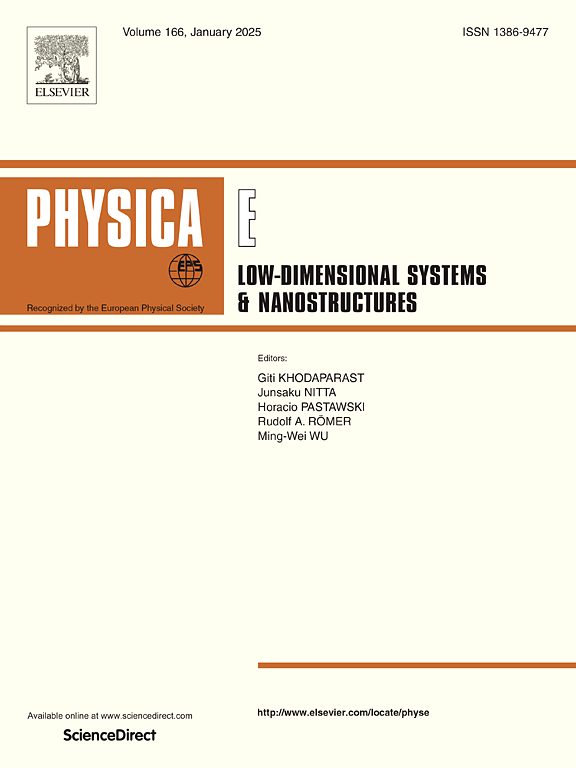Linear and third-order nonlinear optical properties of Germanene nanotubes
IF 2.9
3区 物理与天体物理
Q3 NANOSCIENCE & NANOTECHNOLOGY
Physica E-low-dimensional Systems & Nanostructures
Pub Date : 2025-02-01
DOI:10.1016/j.physe.2024.116171
引用次数: 0
Abstract
This study presents a comprehensive computational investigation of linear and nonlinear optical properties, including third harmonic generation, intensity-dependent refractive index, and DC Kerr effect, of zigzag Germanene nanotubes (GeNTs) with different radii. Calculations were performed using the tight-binding model, beyond the Dirac cone approximation. The linear optical susceptibility spectra reveal a distinct, radius-independent peak in the ultraviolet region, originating from dipole-allowed transitions across the entire Brillouin zone. Remarkably, the nonlinear optical response exhibits multiple resonant peaks below the band gap in the infrared regime, arising from one-, two-, and three-photon processes between valence and conduction states. The third-order nonlinear susceptibility demonstrates a strong dependence on the nanotube radius, with a red-shift in peak positions and an enhancement in peak intensities for larger radii. Variations in intensity and peak position are attributed to the distinct electronic structures of the GeNTs. These findings provide valuable insights into the design and optimization of GeNT-based nonlinear optical devices, enabling potential applications in frequency conversion, optical switching, and advanced photonic technologies.
锗烯纳米管的线性和三阶非线性光学性质
本研究对不同半径之字形锗纳米管的线性和非线性光学性质进行了全面的计算研究,包括三次谐波产生、强度相关折射率和直流克尔效应。计算是使用紧束缚模型进行的,超出了狄拉克锥近似。线性光学磁化率谱在紫外区显示出一个明显的、与半径无关的峰,起源于整个布里渊区允许偶极子的跃迁。值得注意的是,非线性光学响应在红外带隙以下表现出多个共振峰,这是由价态和导态之间的一光子、二光子和三光子过程引起的。纳米管的三阶非线性磁化率与纳米管半径密切相关,随着纳米管半径的增大,纳米管的峰值位置会发生红移,峰值强度会增强。在强度和峰位置的变化归因于不同的电子结构的绅士。这些发现为基于gent的非线性光学器件的设计和优化提供了有价值的见解,使其在频率转换、光开关和先进光子技术方面的潜在应用成为可能。
本文章由计算机程序翻译,如有差异,请以英文原文为准。
求助全文
约1分钟内获得全文
求助全文
来源期刊
CiteScore
7.30
自引率
6.10%
发文量
356
审稿时长
65 days
期刊介绍:
Physica E: Low-dimensional systems and nanostructures contains papers and invited review articles on the fundamental and applied aspects of physics in low-dimensional electron systems, in semiconductor heterostructures, oxide interfaces, quantum wells and superlattices, quantum wires and dots, novel quantum states of matter such as topological insulators, and Weyl semimetals.
Both theoretical and experimental contributions are invited. Topics suitable for publication in this journal include spin related phenomena, optical and transport properties, many-body effects, integer and fractional quantum Hall effects, quantum spin Hall effect, single electron effects and devices, Majorana fermions, and other novel phenomena.
Keywords:
• topological insulators/superconductors, majorana fermions, Wyel semimetals;
• quantum and neuromorphic computing/quantum information physics and devices based on low dimensional systems;
• layered superconductivity, low dimensional systems with superconducting proximity effect;
• 2D materials such as transition metal dichalcogenides;
• oxide heterostructures including ZnO, SrTiO3 etc;
• carbon nanostructures (graphene, carbon nanotubes, diamond NV center, etc.)
• quantum wells and superlattices;
• quantum Hall effect, quantum spin Hall effect, quantum anomalous Hall effect;
• optical- and phonons-related phenomena;
• magnetic-semiconductor structures;
• charge/spin-, magnon-, skyrmion-, Cooper pair- and majorana fermion- transport and tunneling;
• ultra-fast nonlinear optical phenomena;
• novel devices and applications (such as high performance sensor, solar cell, etc);
• novel growth and fabrication techniques for nanostructures

 求助内容:
求助内容: 应助结果提醒方式:
应助结果提醒方式:


